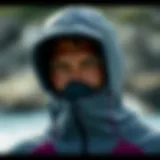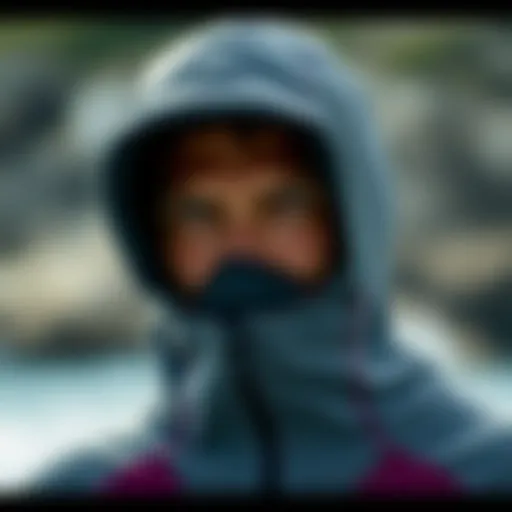The Importance of Eye Protection in Kiteboarding
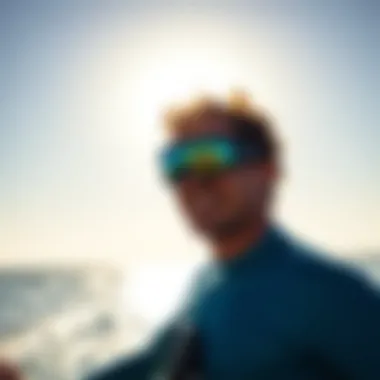
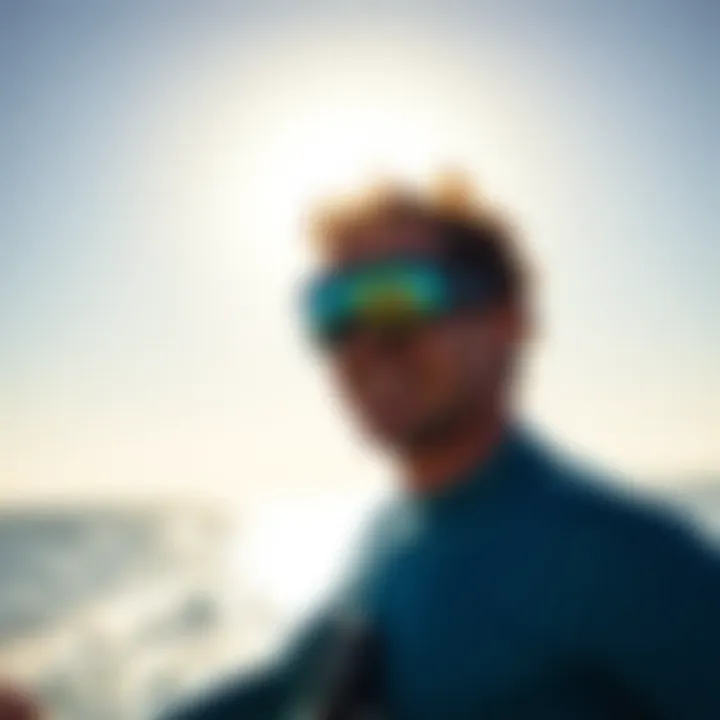
Intro
Kiteboarding is not just a sport; it’s an exhilarating blend of wind, water, and skill that captivates adventurers and thrill-seekers alike. Yet, in the rush of flying above waves and gliding across the sea, it’s easy for enthusiasts to overlook a critical aspect of safety: eye protection. The eyes are not just windows to the soul, they are vital to staying safe and fully enjoying the experience.
When one thinks about kiteboarding, they might conjure images of vibrant kites soaring above, dynamic maneuvers, and the roar of the wind. But the reality is, this exciting sport comes with its own set of hazards. UV rays, wind-blown debris, and even ocean spray can all pose significant threats to vision. Hence, having proper eye protection is not merely advisable; it’s an absolute necessity.
This article will journey through the fundamental reasons kiteboarders must prioritize eye safety, the types of protective gear currently available, practical guidelines for choosing the right equipment, and an informed overview of how environmental factors can impact visual health. With each wave and gust of wind, kiteboarders can deepen their understanding of what it takes to keep vision clear and safe while enjoying their passion.
Prolusion to Eye Protection in Kiteboarding
When it comes to enjoying the exhilarating sport of kiteboarding, many enthusiasts often overlook one crucial aspect: eye protection. Kiteboarding, while thrilling, exposes participants to a host of environmental hazards that demand serious attention, particularly for the eyes.
In this adventure-filled activity, kiteboarders find themselves gliding across the water and soaring high above, often in bright sunlight and with the wind whistling past. This combination can lead to numerous risks, ranging from harmful UV rays to debris flying into the eyes. Eye protection is not just an accessory; it's a necessity that can safeguard vision and enhance performance on the water.
Understanding the Risks
The risks associated with kiteboarding extend beyond the possibility of crashing or losing control. Many kiteboarders face the potential for acute injury from projectiles, such as sand, water droplets, or even equipment parts. Consider the example of a rogue piece of gear, dislodged during a crash landing, that could strike a rider squarely in the eye. Such an incident could not only ruin a day of fun but also lead to long-term vision problems.
Additionally, a common risk includes eye fatigue. Staring into the sun over long periods can lead to discomfort that disrupts enjoyment and focus. Individuals must consider how prolonged exposure can affect their ability to read the wind or adjust their kite—a crucial part of kiteboarding.
The Impact of Sunlight
Bright sunlight also poses a significant threat to eye health. In sunny conditions, just as a sailor adds a layer of sunscreen for skin protection, kiteboarders should think of their eyes in the same way. Ultraviolet (UV) rays can cause immediate discomfort and, more alarmingly, long-term damage such as cataracts or macular degeneration.
Those fun days on the water can turn into a source of regret if preventative measures aren't taken. Keeping a pair of quality sunglasses or goggles on hand isn't merely a suggestion; it’s a smart, responsible choice.
Environmental Hazards
Kiteboarding is often performed in coastal regions where environmental factors come into play. Notably, the presence of saltwater can irritate the eyes, leading to dryness or redness. Beyond that, the wind can whip up dust and particles—common inconveniences that can pose a real threat during a session. Imagine the surf kicking up tiny bits of grit that land in your eyes; more than a mere nuisance, this could distract a kiteboarder from making critical navigational decisions.
Moreover, if a kiteboarder accidentally takes a spill, the sudden immersion in water can impact vision temporarily and confuse orientation, making it challenging to get back upright and moving again. Eye protection serves as a safeguard against these unpredictable variables, ensuring that a kiteboarder stays not only safer but also more focused on the thrill of the ride rather than battling discomfort or vision impairment.
Using appropriate eye protection can dramatically reduce these risks. By understanding the importance of safeguarding one’s vision, kiteboarders can not only maximize their enjoyment but also ensure that they can keep returning to the water for more adventures. This guide will explore the various gear options available to protect one’s eyes, their effectiveness, and best practices to maintain eye health while kiteboarding.
Types of Eye Protection Gear
When it comes to kiteboarding, safeguarding your vision should never take a back seat. The right type of eye protection gear can make all the difference between enjoying your adventure and facing potential hazards. From ocean glare to flying debris, kiteboarders encounter a range of challenges that necessitate robust eye protection. Understanding the various options available helps enthusiasts choose equipment that not only fits well but also offers substantial safeguards against these risks.
Sunglasses for Kiteboarding
Lens Types
The variety of lens types available in sunglasses can be quite significant. You’ve got the standard tinted lenses, which are great for reducing overall brightness, but then there are also categories like UV-protective lenses and photochromic lenses. The standout characteristic of UV-protective lenses is their ability to block harmful rays from the sun, which can inflict long-term damage to eyes during prolonged exposure – a serious concern when gliding across the water under the blazing sun.
On the flip side, photochromic lenses are unique in that they adjust their tint based on light levels. When kiteboarding, this feature can be beneficial if you find yourself moving from shaded areas to bright sunlight, ensuring your eyes are always well protected without having to constantly switch pairs. However, these lenses do take a slight time to react, meaning they may not be the fastest option when you quickly transition from one light level to another.
Polarized vs. Non-Polarized
When evaluating sunglasses for kiteboarding, the debate often boils down to polarized versus non-polarized lenses. The main, eye-catching point of polarized lenses is their ability to cut out glare from the water’s surface, making it easier for kiteboarders to see waves and other potential hazards directly ahead. This enhanced clarity is particularly important, especially when kiteboarding on sunny days when light reflects harshly off the water.
Non-polarized lenses, while still beneficial, might not provide the same degree of visibility under bright conditions. They can, however, deliver accurate color perception, which can be crucial when your surroundings change rapidly. While polarized lenses shine in specific environments, they may also lead to some miscommunications with certain electronics, like LCD screens. Thus, weighing the benefits of polarized lenses against their potential drawbacks is essential for making an informed choice.
Goggles and Their Benefits
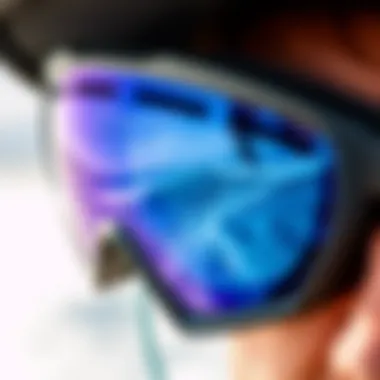
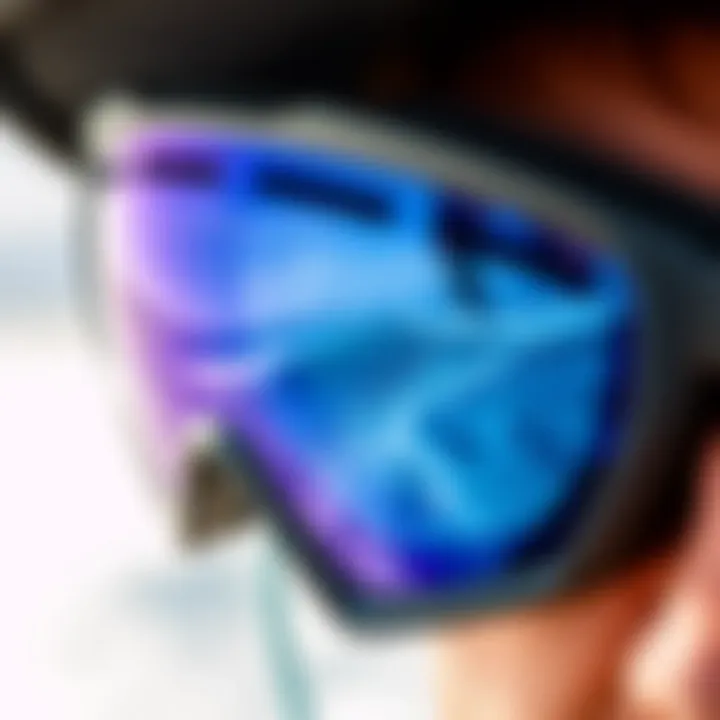
Seal and Protection
Goggles serve as an excellent alternative to traditional sunglasses, especially for those who are serious about eye safety. The most notable characteristic here is their ability to provide a sturdy seal around the eyes, preventing water, wind, and even debris from coming into contact with this sensitive area. A good pair of goggles can keep your eyes clear of saltwater, which can be irritating and obtrusive when kiteboarding.
The seal is a crucial feature as it promotes optimal comfort during rides and protects against environmental elements. Though some may find goggles to be less stylish than sunglasses, their practical advantages often outweigh any aesthetic concerns, particularly during high-speed kiting.
Visibility in Diverse Conditions
Goggles not only protect against the elements but also enhance visibility in varied conditions. Many models come with interchangeable lenses that offer different tints suited to specific weather conditions, such as overcast days versus bright sunlight. The ability to switch out these lenses can make goggles a robust choice for adventurers who face fluctuating weather patterns.
The clear advantage here is the adaptability goggles provide, allowing kiteboarders to maintain excellent visibility no matter the weather. However, it is worth noting that not all goggles offer the same level of comfort, and finding a pair that fits well should be a priority.
Visors and Helmets
Integrated Eye Protection
Visors, often attached to helmets, present an innovative way to integrate eye protection seamlessly with head protection. This combination can be especially appealing to kiteboarders, offering a unified solution that protects both the head and the eyes without the hassle of multiple pieces of gear. The visor shields the eyes from direct sunlight, while the helmet protects against possible impacts – a two-for-one deal that can’t be ignored.
It's important to choose a visor that is made from durable materials to withstand the impacts associated with the sport. However, one negative aspect might be the potential for fogging during rides, which could compromise visibility and lead to dangerous situations if not resolved.
Durability and Comfort
Beyond integrated eye protection, durability and comfort should not be overlooked when selecting visors and helmets. Rigid materials may protect against impacts but can often come at the cost of comfort. Helmets that have additional cushioning will sit better and feel less burdensome during long sessions on the water.
Comfort overrides everything in many cases, and a well-fitted helmet makes a world of difference. The lucky find would be a helmet that feels light yet robust, ensuring that the kiteboarder can enjoy long hours without discomfort. Thus, investing in reliable and comfortable headgear is a must for anyone serious about kiteboarding.
Kiteboarding without proper eye protection is like sailing without a life jacket: you’re just asking for trouble, whether it's from glaring sunlight or unpredictable weather.
Evaluating the Effectiveness of Eye Protection
Ensuring safety while kiteboarding hinges on a full understanding of eye protection's effectiveness. This topic is not just about choosing the right gear; it's essential for safeguarding your eyesight against various risks encountered on the water. The right eye protection can reduce glare, block harmful UV rays, and withstand impacts, making it a cornerstone of kiteboarding safety gear. Evaluating these aspects provides insights into making informed decisions that enhance your experience while preserving your vision.
UV Protection Standards
Ultra Violet (UV) rays are sneaky little devils. They don’t just beat down when the sun's blazing; even on overcast days, these rays can still wreak havoc on your eyes. The sun's harmful rays can lead to various eye issues, including cataracts and macular degeneration. Thus, understanding UV protection standards is pivotal.
A good pair of sunglasses for kiteboarding should have a UV400 rating, meaning they block 100% of UVA and UVB rays. When selecting protective eyewear, always look for specifications indicating their UV protection level. As a rule of thumb, the darker the lens doesn't necessarily mean better protection. Instead, focus on the UV ratings. Moreover, consider the lens material; polycarbonate lenses tend to offer superior UV protection due to their inherent properties.
Always opt for high-quality eyewear that clearly states its UV rating to safeguard your eyes from long-term damage.
Impact Resistance
Kiteboarding exposes you to rapid winds, spray, and at times, crashing waves. Consequently, your eye protection gear must endure impact. Impact resistance standards become crucial in this context; for instance, look for eyewear that meets or exceeds ANSI Z87.1 standards. This specification ensures that your eyewear can withstand a considerable amount of force without shattering.
While traditional lenses can break under stress, polycarbonate and Trivex materials offer exceptional impact resistance without sacrificing clarity. Choosing eyewear made from these materials minimizes the risks associated with debris or sudden falls during your thrilling sessions on the waves.
In addition, look for gear that fits snugly around your eyes. A well-fitting pair of goggles or sunglasses will shield against flying particles and moisture that can obstruct your vision and pose risks.
Fit and Comfort
Comfort should never take a back seat when it comes to eye protection. No matter how high-end or fancy your eyewear may be, if it’s uncomfortable, you won't wear it. The fit is vital because it affects your vision and overall experience. Eyewear should sit comfortably without pinching or slipping, providing a secure fit during intense activities.
Take into consideration the frame style, adjustable straps, and even the weight of the eyewear. Some anglers and adventurers find wraparound styles particularly advantageous, as they block light and wind from entering from the sides. Moreover, the cushioning around the lens areas can help prevent discomfort during long hours on the water.
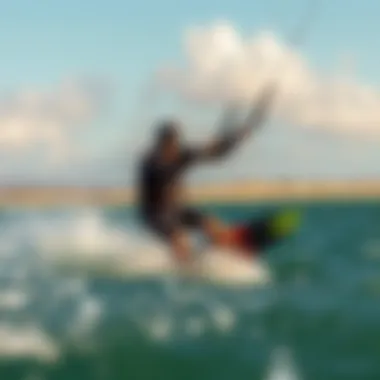

Furthermore, remember that you might need to adapt to different conditions, such as switching lenses based on sunlight intensity. Choosing protective eyewear with interchangeable lenses can allow you to customize your protection for specific kiteboarding conditions. Ultimately, investing time in finding the right gear reflects commitment to one of the most critical aspects of your overall kiteboarding safety.
Best Practices for Eye Safety
Ensuring eye safety while kiteboarding is pivotal not just for enjoying the sport but also for preserving one's vision for years to come. Adapting a few best practices can significantly reduce the risks associated with eye injuries, glare from the sun, and other environmental factors that kiteboarders face. Here, we delve into some crucial approaches, emphasizing their role in effective eye care.
Regular Maintenance of Gear
One of the cornerstones of eye safety is maintaining your protective gear. Just as one would tune up their kite and harness, it's essential to keep your eyewear in optimal condition. Regularly check for scratches or cracks on your sunglasses or goggles, as even a tiny blemish can distort vision or let harmful rays seep through. Dirty lenses can further hinder visibility—make it a habit to clean them with gentle, non-abrasive cleaners and cloths.
- Check for Scratches: Inspect your lenses frequently; replace them if they have significant damage.
- Cleaning: Use a microfiber cloth and mild soap to clean lenses for clarity. Avoid paper towels that might scratch.
- Storage: Always store your eyewear in a protective case when not in use; this prevents scratches and damage during transit.
By keeping gear well-maintained, you’re not only prolonging its life but ensuring your eyes stay shielded from potential setbacks.
Adjusting to Conditions
Kiteboarding is often influenced by rapidly changing weather conditions and varying levels of sun exposure. Adapting your eye protection according to these environmental shifts is vital. For instance, transitioning from a sunny midday to an overcast afternoon can substantially impact light perception.
- Lens Tint: Consider using interchangeable lenses that can adapt to different lighting—dark lenses for bright sunny days, and lighter tints for overcast conditions.
- Polarization: On windy days, the water might reflect an extraordinary amount of glare. Polarized lenses can help cut through this glare, making it easier to see the water's surface, ensuring a smoother ride and safer experience.
Adjusting your protective gear to avoid eye strain and maintain optimal visibility improves comfort significantly, which allows for a more enjoyable experience on the water.
Educating Others
Awareness is a key defensive strategy in kiteboarding. As you participate in this thrilling sport, you gather experience and knowledge that could benefit other enthusiasts, be they novice kiteboarders or those who’ve been in the sport for years. Sharing insights about the importance of eye protection can foster a culture of safety within the kiteboarding community.
- Workshop Sessions: Organize informal gatherings or workshops that emphasize the importance of eye safety and demonstrated best practices concerning gear maintenance.
- Social Media Groups: Engage in discussions on platforms like Reddit or dedicated Facebook groups where kiteboarding enthusiasts share gear tips and experiences.
- Teach by Example: When out on the water, visibly using your protective gear and practicing good habits can serve as a powerful example for others, encouraging them to prioritize their eye safety.
By promoting awareness and safety practices, you can help create a community where the risks associated with kiteboarding are acknowledged, and smart choices about eye health are made collectively.
"Your eyes are a treasure; take good care of them, especially while conquering the waves."
Environmental Considerations
When kiteboarding, the environment plays a significant role in both safety and enjoyment. Understanding the environmental factors that impact your vision is crucial. With intense sunlight reflecting off the water and the abrasive nature of saltwater, kiteboarders face unique challenges that can compromise eye health. This section sheds light on these specific environmental concerns and their implications for eye protection.
Dealing with Glare
Glare from sunlight can be as blinding as a deer caught in headlights. For kiteboarders, this glare often comes off the water, creating a visual hazard that can obscure obstacles or other riders. Wearing quality polarized sunglasses or goggles significantly alleviates this problem by filtering out the light that causes the glare. Polarized lenses work particularly well in this regard. They reduce reflections and enhance contrast, allowing you to spot changes in the water's surface, which is vital for maneuverability.
- Consider the conditions: Overcast days also produce glare since the clouds scatter sunlight randomly. Thus, it can be helpful to have a pair of sunglasses with clear or slightly tinted lenses as a backup.
- Different angles: Tilt your head or change your perspective. Sometimes simply adjusting where you look can help make the water safer to navigate. But relying on proper eye protection should always come first.
"A clear view of the horizon can be the difference between a thrilling ride and an unexpected wipeout."
Saltwater and Its Effects
Saltwater is another environmental element that kiteboarders should consider when evaluating eye protection. While the thrill of riding the waves is exhilarating, exposure to saltwater can have adverse effects on your eyes. For one, saltwater can irritate your eyes if they come into direct contact with it, causing redness and discomfort. Over time, consistent exposure without adequate protection could lead to conditions like dry eye syndrome or even infections.
Utilizing goggles that create a watertight seal can be beneficial in these situations. These can prevent saltwater from entering your eyes and provide clear vision, even in choppy waters. Also, keeping suitable saline solution handy can help rinse your eyes after a long day on the water. Determining the best protection and maintenance routines is essential to keep your eyes happy and healthy.
- Wash your eyes: Use clean water to wash off any salt after heading ashore. This simple act can reduce irritation significantly.
- Moisture matters: Consider using lubricating eye drops specially formulated for saltwater exposure if you notice persistent dryness or irritation. These can offer added comfort and protection.
Making an effort to understand how glare and saltwater affect your eyes can elevate your kiteboarding experience while helping you avoid unwanted consequences. Ensuring adequate eye protection against these environmental factors is a cornerstone of preserving your vision and enjoying the ride.
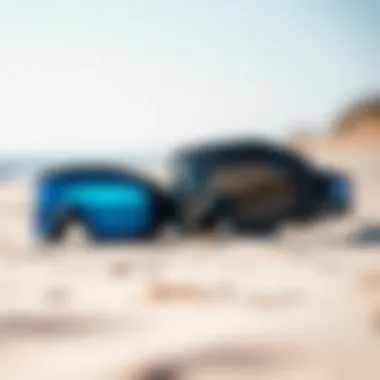

Innovations in Eye Protection Technology
The dynamic realm of kiteboarding has consistently pushed the boundaries of what's possible, both in performance and safety. Innovations in eye protection technology are crucial, considering how vital clear sight is to navigate through the potential hazards of the sport. Not only do these technologies advance the level of safety, they also enhance the overall experience for kiteboarders. As kiteboarding continues to grow, so too does the need for cutting-edge solutions to protect one of our most precious resources—our vision.
Emerging Materials
Recent years have witnessed significant strides in the materials used for eye protection gear. Traditional sunglasses and goggles, while effective, often lacked the durability and adaptability required in the ever-changing environment of kiteboarding. Enter emerging materials designed specifically for this sport.
For kiteboarders, choosing protective eyewear made from polycarbonate lenses has become increasingly favorable. This type of material is not only lightweight but also boasts a high level of impact resistance. When a kite or board comes barreling towards you at speed, the last thing you want is to worry about your goggles shattering on impact.
Moreover, new anti-fog coatings are being developed with advanced chemical processes that enhance visibility in diverse weather conditions. These coatings significantly reduce the chances of fogging up when you’re out there, creating a seamless connection between you and your environment.
"Protecting your eyes while kiteboarding is just as essential as wearing a helmet; you need them in their best shape to ride the waves!"
To summarize the benefits of these emerging materials:
- Lightweight: Reduces fatigue and increases comfort during long sessions.
- Impact-resistant: Safeguards your eyes from sudden impacts and debris.
- Anti-fog properties: Ensures clear vision under varying climatic situations.
Smart Technology in Eye Gear
The incorporation of smart technology into eye gear represents a forefront of innovation for kiteboarders. Modern goggles and sunglasses are not merely passive social accessories anymore but have evolved into sophisticated gadgets that provide real-time information to enhance safety and performance.
Consider, for instance, the emergence of goggles equipped with augmented reality (AR) capabilities. These advanced devices can project critical information such as speed, distance travelled, and even wind conditions directly in your field of vision. This enables you to stay focused on your ride while garnering valuable insights that could improve your technique or help you steer clear of potential danger.
Additionally, some smart eyewear integrates with smartphone apps that track user performance metrics, offering tips and suggestions for improvement. Imagine a scenario where your eyeglasses notify you when optimal lighting conditions change or if you're facing glare, helping you to adjust your eye protection accordingly.
Key points about smart technology in eye gear include:
- Real-time data: Keeps essential performance metrics readily accessible.
- Enhanced decision-making: Elevated awareness can lead to safer kiteboarding experiences.
- Integration with apps: Tracks performance over time, facilitating targeted improvements.
In the face of evolving technology landscapes, it is crucial for kiteboarders to stay informed about the latest innovations in eye protection. These advancements not only safeguard your vision but also enhance your experience on the water, making them indispensable in today’s kiteboarding culture.
The End and Future Outlook
Understanding the significance of eye protection in kiteboarding cannot be overstated. Kiteboarding, with its thrills and spills, exposes participants to various environmental challenges that imperil the eyes. Both seasoned enthusiasts and novices alike must grapple with the multitude of risks: blinding sunlight, salt spray, and debris from the water, among others. Thus, fostering awareness and education around the right eye protection gear emerges as paramount.
As technology advances, kiteboarders are witnessing innovations aimed at enhancing the effectiveness of protective eyewear. Emerging materials show promise, offering lighter yet more durable options that shield the eyes without sacrificing comfort. For instance, gear made from polycarbonate lenses has become increasingly favored due to its excellent impact resistance and UV shielding abilities. Encouragingly, such developments indicate a forward momentum toward better eye health protections in the sport.
Moreover, a cultural shift towards prioritizing safety is essential. In the exhilarating realm of kiteboarding, many may overlook their eye health in the excitement of the moment. But incorporating routine checks and a strong adherence to using protective gear can transform attitudes.
"An ounce of prevention is worth a pound of cure."
This adage rings especially true here; taking proactive steps can mitigate risks significantly, ensuring that kiteboarders can navigate the waves both safely and joyfully.
Final Thoughts on Eye Protection
Reflecting upon the discourse surrounding eye protection reveals overwhelming consensus: the eyes are delicate and require diligent care, particularly in high-speed environments like kiteboarding. The spectrum of hazards presented by nature while engaging in this sport underscores the imperative nature of safeguarding one’s vision. Opting for suitable sunglasses, goggles, or visors can equip a kiteboarder not only with style but also with peace of mind against environmental threats.
To wrap it up, kiteboarders must regard eye safety as fundamental to their overall wellbeing. It’s not merely a matter of personal preference, but a necessary step towards sustaining one’s ability to continue enjoying this outdoor adventure. Protecting one’s eyes shouldn’t be an afterthought—it ought to be part of every kiteboarder's toolkit.
Encouraging a Culture of Safety
Promoting a culture of safety within the kiteboarding community calls for collective responsibility. This could begin with instructors, especially those who welcome newcomers to the sport. Setting the stage with clear safety protocols and the importance of eye gear can create a ripple effect, encouraging others to prioritize their eyesight.
Additionally, peer-to-peer education can go a long way. When experienced kiteboarders share their stories of how eye protection saved the day or prevented serious injury, it solidifies the message across the community. Social media platforms can play a critical role in spreading awareness, making safety not only a personal duty but a collective ethos.
As kiteboarding continues to evolve, so must our approach to safety. The call for adopting smart technologies in eye gear and materials that respond to changing environments will enhance protection measures. In this thrilling pursuit of adventure, it is ultimately the commitment to eye safety that ensures the fun continues for years to come.
Embracing these practices will lead to healthier eyes and more exhilarating experiences for kiteboarders everywhere.














